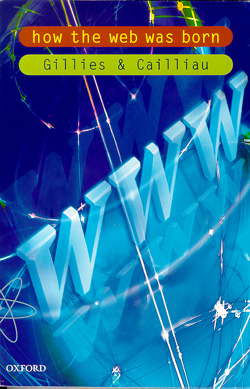

![]()
![]()

This fascinating book provides a personalised account not only of the technological developments that underpin the WWW, but also provides a picture of the interwoven elements of human endeavor and ideology that enabled the technology to take the form of the global communication tool that currently exists. The story is presented over eight chapters and an epilogue. It describes the original genesis of the Web and provides details of prominent roles played in its development by Tim Berners-Lees, an English computer scientist (portrayed as a main driving force behind the "idea" of the Internet) as well as many other key individuals, including Robert Cailliau, one of the authors. It also sets out the parallel and related roles that major commercial and research organisations, and US and various European governments played in funding and developing the idea. Most interestingly, the book provides an insight into the individual and collective struggles of those involved in realising their aspirations of the Internet as it took shape. Alongside this story, a detailed account of the hardware and software developments that enabled the WWW to function is presented.
Chapter two is particularly interesting as describes the development of Internet technology and "philosophy " from the perspective of the associated computer scientists alongside the concomitant political and corporate thinking and decision making of the '70s and early '80s, which the authors argue, has ultimately helped to shape its current nature and appearance. Chapter eight also stands out as it sets out the more recent geopolitical dynamics that underpinned the official adoption of the WWW as the main means of networking between computers using the vehicle of the Internet, and the steps taken by the author and Tim Berners-Lees to ensure the Web software was made freely available to everyone.
This book has a number of key strengths. Firstly, because the story is told using excerpts from interviews and conversations held with the main protagonists in this story, you gain a real sense of the human dimension underpinning this highly technical and mechanistic phenomenon. Secondly, this story will inevitably be told again and again from a variety of philosophical, ideological and historical perspectives. The fact that one of book's authors is one of those very closely associated with the early development of the WWW, should help set it apart as one of the more accurate accounts of the story. Thirdly, and on a practical level, a timeline depicting the key advances in the history and development of computers, networks and hypertext alongside important global events is presented. In addition, an annotated bibliography is also offered with details of a comprehensive range of printed and web based sources of written and audiovisual material. There is also a helpful list of acronyms and an alphabetical listing of individuals.
The main weakness of the book relates to its usefulness as an academic reference book, which enables the reader to quickly locate individuals and events. For example, there is no overview section or chapter to describe the order and content of chapters, which means that you have to rely on the index or skim read each book chapter to gain a sense of its content. At the same time the chapter titles while catchy sounding; don't provide a clear notion of their subject matter. However, despite these limitations, it is highly readable book.
The primary target audience for this book is likely to be students and researchers interested computing and information sciences. However, social science students and researchers interested in the Internet and the World Wide Web as an area of social research, as well as those interested in the Internet based research will also find this book interesting and informative.
Flora Douglas
Medical School, University of Aberdeen